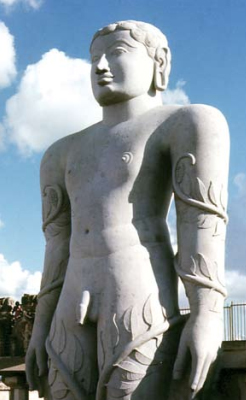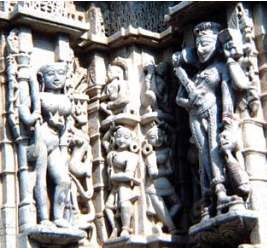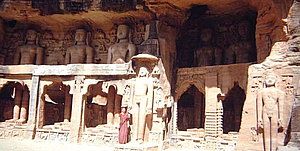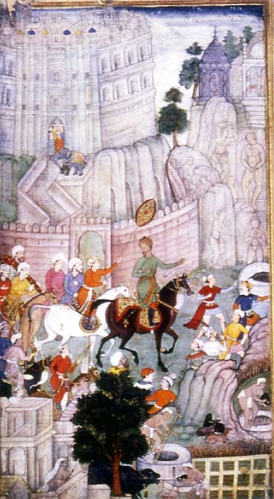
Centre of Jaina Studies Newsletter: SOAS - University of London
Male nudity is a distinguishing characteristic of Digambara iconography, and one that clearly distinguishes it from that of the Jaina Śvetāmbaras. In the Digambara tradition, nudity signifies the full discarding of all possessions and reflects the actions of all of the Jinas in the line of twenty-four. According to the Śvetāmbaras, only the first and the last Jinas, Ṛṣabha and Mahāvīra, did so. Śvetāmbara modesty is such that their icons always appear as clothed. Even when illustrating stories of Mahāvīra giving away his last garment in two halves, they depict him as clothed. This was not always the case. In Jaina art during the early years of the common era, all Jinas were depicted as nude. It was only after the Jaina sects formally split into two distinct groups that differences in iconography emerged.
In depicting the Jinas and other meditating Jaina figures, the Digambaras most often depict figures in kāyotsarga mudrā, standing in meditation with the arms pendant held away from the body. The largest freestanding example of this is the gigantic Bāhubali at Śravaṇabeḷgoḷa. (Figure 1) The nudity of the figure is graphically displayed; essentially it is a statement of Digambara identity. The Śvetāmbaras also use this posture, but almost invariably for attendant Jinas in their images with three or five Jinas; the central one is almost always seated.
When Jaina Digambara imagery developed there were a number of contemporaneous sects espousing nude asceticism. Some of these also depicted nude imagery, but mainly with a different intent. For example, while Digambara depictions emulated the Jinas, that of Hindu sādhus often showed Śiva expiating a great sin. Whereas the Digambara renounces all attachments and the nudity of the ascetic is associated with purity, in the case of Śiva, the same can be employed to flaunt convention and is associated with all types of unclean activities. Śiva is often depicted in human form as nude with his phallus exposed, which links his iconic form with the aniconic liṅga.[1] In iconographic representations, the figure of the ascetic Śiva is often combined with ghosts and a common setting is in cremation grounds. This is quite evident when Śiva is depicted as the horrific Bhairava or as the ascetic Bhikṣaṭanamūrti. This nudity refers to his ascetic nature and his lack of social conformity. While this asceticism could be compared to the Digambara monk's shedding of clothing, in Śiva's case it functions as a way of alienating him from society; his horrific form is very different from a naked Jaina monk or Jina image.

Figure 1. Bāhubali, Śravaṇabeḷgoḷa, Karṇāṭaka, 981 CE. Photo: Robert J. Del Bontà, 1974
A medieval Hindu sect known as the Kāpālikas, offers an interesting contrast to the Digambaras, in that some of the same imagery appears in the iconography of both groups. The nude form of Śiva that they worshipped was a Bhairava known as Brahmaśiraśchedakamūrti, and depictions of this iconography are found over a large area on both Hindu and Jaina temples in Karṇāṭaka and stretching to the far north. The image appears to be associated with a sect of Śaivism very different from Jainism, but its apotropaic importance is widespread. In a Jaina context we find Brahmaśiraśchedakamūrti at various sites, including both Jaina temples at Ranakpur. There the image is also placed alongside a nude female figure, which has been identified as Brahmahatyā, a personification of Brahmanicide, the sin committed by Śiva.[2] (Figure 2)
Contrary to what one would expect in a Jaina context, the male figure holds a severed head in one of his hands, a head which in later, popular Kāpālika narratives becomes the skull cup (kapāla) used as a begging bowl.

Figure 2. Brahmaśiraśchedakamūrti and Brahmahatyā, Ādinātha temple, Ranakpur, Rājasthān, 1439 CE. Photo: Robert J. Del Bontà, 1987.
This iconography is the main focus of the Kāpālikas. In this sect ascetics essentially take on the punishment for the sin of Brahmanicide, and like Śiva after he lopped off the fifth head of Brahmā, they wander about naked for twelve years to expiate that sin. Similar to the image that they worship, they carry a kapāla used as a begging bowl. In contrast, the Digambara monk, a nude ascetic for an entirely different purpose, does not use a bowl at all but makes one with his cupped hands. In this iconography, Śiva shares asceticism with the Digambara figures, but the figure of Śiva in an ithyphallic state, with his member erect, is even more common, often even when he is wearing clothing. This distances him further from nude Digambara monks and imagery, which invariably depicts the figure in a meditation posture.[3]
Over the centuries a sense of indecency began to develop with regard to nude imagery, including depictions of Digambara mendicants. This is mainly because it made some outsiders uncomfortable, especially in the case of male representations. When, for example, the Mughal emperor Bābur visited Gwalior in 1528 and saw the colossal nude Jinas there he wrote,"They are shown stark naked with all their private parts exposed.... Its one drawback was the idols, so I ordered them destroyed."[4] This destruction clearly did not take place, although some mutilation may have occurred, but screens were built in front of many, if not all, of the colossi to hide their nudity after Bābur's visit. (Figure 3) Bābur's embarrassment is manifest in a late 16th-century painting from the Bāburnāma (Bābur's memoirs) depicting the colossal figures at Gwalior the Jina images do not stand upright, but take on other postures. Three wear loin cloths and one hides his genitals. (Figure 4)
Male nudity appears in various forms in Indian art, but does not always serve the same purpose. Here, we have discussed that of the Digambaras, contrasting it primarily with one aspect of Śaiva iconography. Both suggest asceticism, but the actual practice of asceticism amongst the two groups reflects very different intents that of the Śaiva reflects violence not expected in a Jaina context with its emphasis on non-violence, ahiṃsā. The fact that similar imagery appears on some Jaina temples demonstrates how local, contemporaneous iconographies were taken into Jainism.

Figure 3. Colossal Jinas, Gwalior, first half of 15th century. Photo: Robert J. Del Bontà, 1974.
Robert J. Del Bontà has lectured and published on a wide variety of subjects including Jaina art from all over India. He has curated many exhibits at the Asian Art Museum of San Francisco and was a major contributor to The Victorious Ones: Jain Images of Perfection at the Rubin Museum of Art.

Figure 4. Bābur at Gwalior, from a Bāburnāma manuscript, by the artist Dhanraj, Mughal Period, ca. 1590 © British Library Board Vagi 'at-i Baburi/Or.3714, f.478 Photo: Ellen S. Smart
In Hindu iconography Śiva is the god who is most often depicted as nude. Śiva is also often shown simply in the form of a liṅga or phallus. The liṅga can be interpreted in philosophical ways, but the symbolism of its physical, procreative power cannot be ignored. It can be represented as a simple rounded column, but can also appear with one face (ekamukha liṅga) or even with four faces (caturmukha liṅga). The latter depicts the five-headed form of the god, the fifth head being invisible and directed to the heavens. The directionality of the four-faced variety can be compared to the Jaina caturmukha form, which illustrates the Universal Assembly (samavasaraṇa) of the Jina upon reaching enlightenment.
For a discussion of the Kāpālikas, see: Pramod Chandra, "The Kaula-Kāpālika Cults at Khajuraho," Lalit Kalā, Nos. 1-2, April 1955March 1956 and Robert J. Del Bonta, "Brahmaśiraśchhedakamūrti, Brahmahatyā, and Ritualistic Suicide in Medieval Karṇāṭaka", Chhavi2. The Rai Krishnadas Felicitation Volume, Banaras: Bharat Kala Bhavan, 1981, pp. 119-122.
Knut Auckland discussed a similar crossover image at a Śvetāmbara centre, the Nākoḍā Bhairava. ('The Cult of Nākoḍā Bhairava: Deity Worship and Possession in Jainism'. Jaina Studies. Newsletter of the SOAS Centre of Jaina Studies, 6 (2011) pp. 31-33). Although both figures can be categorized under the umbrella 'Bhairava', a form of Śiva, the specific iconography in Figure 2, which includes the severed head, is quite different from the Nākoḍā icon, who carries similar weapons and a begging bowl but no head. At the same time, an icon at Nākoḍā outside the temple complex, which Auckland labels as Kālā Bhairava, carries the head. Kālā Bhairava probably inspired the benign, more Jaina, image in the temple itself. Auckland states that this image is hard to justify within a non-violent Jaina context, but it is one found over a wide area at both Jaina and Hindu centres.
 Dr. Robert J. Del Bonta
Dr. Robert J. Del Bonta